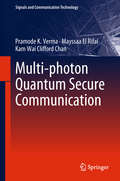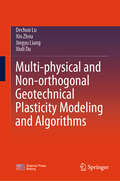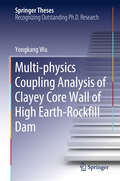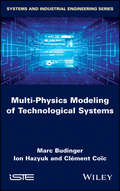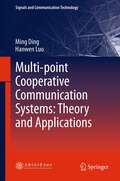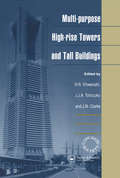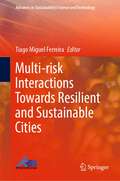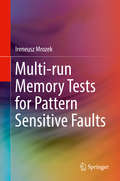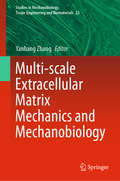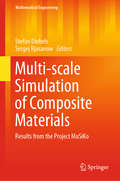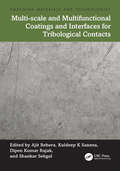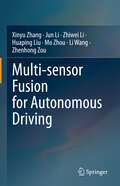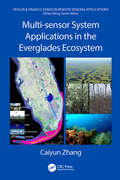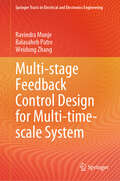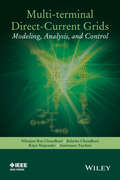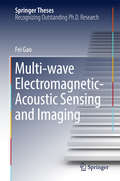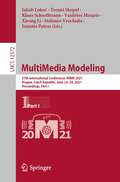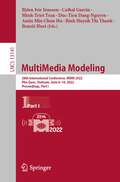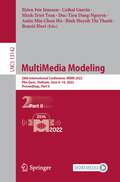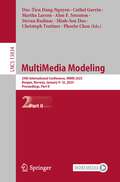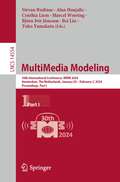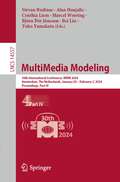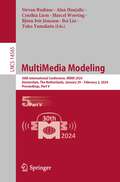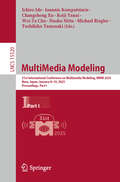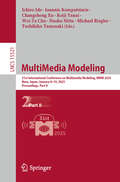- Table View
- List View
Multi-photon Quantum Secure Communication (Signals and Communication Technology)
by Pramode K. Verma Mayssaa El Rifai Kam Wai ChanThis book explores alternative ways of accomplishing secure information transfer with incoherent multi-photon pulses in contrast to conventional Quantum Key Distribution techniques. Most of the techniques presented in this book do not need conventional encryption. Furthermore, the book presents a technique whereby any symmetric key can be securely transferred using the polarization channel of an optical fiber for conventional data encryption. The work presented in this book has largely been practically realized, albeit in a laboratory environment, to offer proof of concept rather than building a rugged instrument that can withstand the rigors of a commercial environment.
Multi-physical and Non-orthogonal Geotechnical Plasticity Modeling and Algorithms
by Xiuli Du Dechun Lu Xin Zhou Jingyu LiangThis book primarily introduces innovative multi-physical plastic modeling for geomaterials in unsteady environments and advanced numerical methods for elastoplastic models, topics not systematically covered in other literature. The constitutive models in the form of stress-strain-environment will be interesting to students and researchers in geotechnical engineering and rock and soil mechanics. The book provides a thorough exploration of modeling techniques and algorithmic flowcharts, facilitating a deeper understanding of both theoretical models and numerical methods. It also guides readers in applying these tools to describe the mechanical behavior of geomaterials in various unsteady environments and addresses computational challenges in elastoplastic numerical analysis.
Multi-physics Coupling Analysis of Clayey Core Wall of High Earth-Rockfill Dam (Springer Theses)
by Yongkang WuNominated by Tsinghua University as an outstanding Ph.D. thesis, this book investigates the mechanical properties of unsaturated compacted clayey soil, the multi-field coupling consolidation theory of unsaturated soil and its application to a 261.5 m high earth-rockfill dam. It proposes a multi-field coupling analysis method of consolidation, and develops an efficient and practical finite element (FE) program for large-scale complex earth-rockfill dams. The book is primarily intended for researchers studying the multi-field coupling analysis of seepage consolidation.
Multi-physics Modeling of Technological Systems
by Marc Budinger Ion Hazyuk Clément CoïcThe development of mechatronic and multidomain technological systems requires the dynamic behavior to be simulated before detailed CAD geometry is available. This book presents the fundamental concepts of multiphysics modeling with lumped parameters. The approach adopted in this book, based on examples, is to start from the physical concepts, move on to the models and their numerical implementation, and finish with their analysis. With this practical problem-solving approach, the reader will gain a deep understanding of multiphysics modeling of mechatronic or technological systems – mixing mechanical power transmissions, electrical circuits, heat transfer devices and electromechanical or fluid power actuators. Most of the book's examples are made using Modelica platforms, but they can easily be implemented in other 0D/1D multidomain physical system simulation environments such as Amesim, Simulink/Simscape, VHDL-AMS and so on.
Multi-point Cooperative Communication Systems: Theory and Applications
by Hanwen Luo Ming DingMulti-point Cooperative Communication Systems: Theory and Applications mainly discusses multi-point cooperative communication technologies which are used to overcome the long-standing problem of limited transmission rate caused by the inter-point interference. Instead of combating the interference, recent progress in both academia and industrial standardizations has evolved to adopt the philosophy of "exploiting" the interference to improve the transmission rate by cooperating among multiple points. This book addresses the multi-point cooperative communication system systematically giving the readers a clear picture of the technology map and where the discussed schemes may fit. This book includes not only the theories of the paradigm-shifting multi-point cooperative communication, but also the designs of sub-optimal cooperative communication schemes for practical systems. Ming Ding is a senior researcher at Sharp Laboratories of China; Hanwen Luo is a professor at Shanghai Jiao Tong University.
Multi-purpose High-rise Towers and Tall Buildings
by H. R. Viswanath J.J.A. Tolloczko J. N. ClarkeInterest continues to develop in the design and construction of high-rise towers and tall buildings, structures with heights ranging from 75m to 500m and even more. This volume presents the papers from the third in a series of international conferences on the subject, organised by the International Federation of High-rise Structures. The papers hav
Multi-risk Interactions Towards Resilient and Sustainable Cities (Advances in Sustainability Science and Technology)
by Tiago Miguel FerreiraFor years, researchers have studied the risks of individual natural hazards in urban areas. However, the impact of multiple hazards has not yet received widespread attention in research and urban management practice, which is a significant gap in the current climate change context. This book aims to contribute to filling that gap by examining the process of identifying, assessing, and managing multi-hazard risks in urban areas. From identifying and assessing the vulnerability of the elements exposed to the impact of natural hazards, including earthquakes, floods, fires, and landslides, this book covers all the critical stages of multi-hazard risk assessment and management in a climate change context. The concepts and approaches discussed in the book are applied to the Lisbon Metropolitan Area, a dynamic and thriving metropolis, allowing readers to see those theories applied in a real setting. In addition to providing a solid theoretical foundation, this book offers practical guidelines for conducting risk assessment at the metropolitan scale, which makes it a valuable resource for researchers, practitioners, and decision-makers interested in understanding and managing multi-hazard risks in urban areas.
Multi-run Memory Tests for Pattern Sensitive Faults
by Ireneusz MrozekThis book describes efficient techniques for production testing as well as for periodic maintenance testing (specifically in terms of multi-cell faults) in modern semiconductor memory. The author discusses background selection and address reordering algorithms in multi-run transparent march testing processes. Formal methods for multi-run test generation and many solutions to increase their efficiency are described in detail. All methods presented ideas are verified by both analytical investigations and numerical simulations.Provides the first book related exclusively to the problem of multi-cell fault detection by multi-run tests in memory testing process;Presents practical algorithms for design and implementation of efficient multi-run tests;Demonstrates methods verified by analytical and experimental investigations.
Multi-scale Extracellular Matrix Mechanics and Mechanobiology (Studies in Mechanobiology, Tissue Engineering and Biomaterials #23)
by Yanhang ZhangThis book describes the current state of knowledge in the field of multi-scale ECM mechanics and mechanobiology with a focus on experimental and modelling studies in biomechanical characterization, advanced optical microscopy and imaging, as well as computational modeling. This book also discusses the scale dependency of ECM mechanics, translation of mechanical forces from tissue to cellular level, and advances and challenges in improving our understanding of cellular mechanotransduction in the context of living tissues and organisms.
Multi-scale Simulation of Composite Materials: Results from the Project MuSiKo (Mathematical Engineering)
by Stefan Diebels Sergej RjasanowDue to their high stiffness and strength and their good processing properties short fibre reinforced thermoplastics are well-established construction materials.Up to now, simulation of engineering parts consisting of short fibre reinforced thermoplastics has often been based on macroscopic phenomenological models, but deformations, damage and failure of composite materials strongly depend on their microstructure. The typical modes of failure of short fibre thermoplastics enriched with glass fibres are matrix failure, rupture of fibres and delamination, and pure macroscopic consideration is not sufficient to predict those effects. The typical predictive phenomenological models are complex and only available for very special failures. A quantitative prediction on how failure will change depending on the content and orientation of the fibres is generally not possible, and the direct involvement of the above effects in a numerical simulation requires multi-scale modelling.One the one hand, this makes it possible to take into account the properties of the matrix material and the fibre material, the microstructure of the composite in terms of fibre content, fibre orientation and shape as well as the properties of the interface between fibres and matrix. On the other hand, the multi-scale approach links these local properties to the global behaviour and forms the basis for the dimensioning and design of engineering components. Furthermore, multi-scale numerical simulations are required to allow efficient solution of the models when investigating three-dimensional problems of dimensioning engineering parts.Bringing together mathematical modelling, materials mechanics, numerical methods and experimental engineering, this book provides a unique overview of multi-scale modelling approaches, multi-scale simulations and experimental investigations of short fibre reinforced thermoplastics. The first chapters focus on two principal subjects: the mathematical and mechanical models governing composite properties and damage description. The subsequent chapters present numerical algorithms based on the Finite Element Method and the Boundary Element Method, both of which make explicit use of the composite’s microstructure. Further, the results of the numerical simulations are shown and compared to experimental results.Lastly, the book investigates deformation and failure of composite materials experimentally, explaining the applied methods and presenting the results for different volume fractions of fibres.This book is a valuable resource for applied mathematics, theoretical and experimental mechanical engineers as well as engineers in industry dealing with modelling and simulation of short fibre reinforced composites.
Multi-scale and Multifunctional Coatings and Interfaces for Tribological Contacts (Emerging Materials and Technologies)
by Dipen Kumar Rajak Ajit Behera Kuldeep K Saxena Shankar SehgalThis book covers developments in multi-scale and multifunctional coatings, including strategies in the preparation, characterization, and properties of both thin and thick multifunctional coatings along with their corresponding application. Various technologies for processing, characterization, and tribology effects of various coating surfaces and interfaces are discussed. It describes smart surfaces like piezoelectric materials, shape memory alloys, shape memory ceramics, magnetostrictive materials, electrostrictive materials, dielectric materials, and advanced ceramics. Explains multifunctional materials with respect to their tribology behavior at surface and interface. Covers analysis techniques for multifunctional surfaces and interfaces. Discusses emerging applications of multifunctional surfaces. Explores multifunctionality of thin films as well as thick coatings. This book is aimed at graduate students and researchers in metallurgical engineering, materials science, and nanosciences.
Multi-sensor Fusion for Autonomous Driving
by Jun Li Li Wang Huaping Liu Mo Zhou Zhiwei Li Xinyu Zhang Zhenhong ZouAlthough sensor fusion is an essential prerequisite for autonomous driving, it entails a number of challenges and potential risks. For example, the commonly used deep fusion networks are lacking in interpretability and robustness. To address these fundamental issues, this book introduces the mechanism of deep fusion models from the perspective of uncertainty and models the initial risks in order to create a robust fusion architecture. This book reviews the multi-sensor data fusion methods applied in autonomous driving, and the main body is divided into three parts: Basic, Method, and Advance. Starting from the mechanism of data fusion, it comprehensively reviews the development of automatic perception technology and data fusion technology, and gives a comprehensive overview of various perception tasks based on multimodal data fusion. The book then proposes a series of innovative algorithms for various autonomous driving perception tasks, to effectively improve the accuracy and robustness of autonomous driving-related tasks, and provide ideas for solving the challenges in multi-sensor fusion methods. Furthermore, to transition from technical research to intelligent connected collaboration applications, it proposes a series of exploratory contents such as practical fusion datasets, vehicle-road collaboration, and fusion mechanisms. In contrast to the existing literature on data fusion and autonomous driving, this book focuses more on the deep fusion method for perception-related tasks, emphasizes the theoretical explanation of the fusion method, and fully considers the relevant scenarios in engineering practice. Helping readers acquire an in-depth understanding of fusion methods and theories in autonomous driving, it can be used as a textbook for graduate students and scholars in related fields or as a reference guide for engineers who wish to apply deep fusion methods.
Multi-sensor System Applications in the Everglades Ecosystem (Remote Sensing Applications Series)
by Caiyun ZhangThis book explores the applicability of multiple remote sensors to acquire information relevant to restoration and conservation efforts in wetlands using data collected from airborne and space multispectral/hyperspectral sensors, light detection and ranging (LiDAR), Unmanned Aircraft Systems (UAS), and a hand-held spectroradiometer. This book also examines digital data processing techniques such as object-based image analysis, machine learning, texture analysis, and data fusion. After an introduction to the Everglades and to remote sensing, the book is divided into four parts based on the sensor systems used. There are chapters on vegetation mapping, biomass and water quality modeling, applications of hyperspectral data for plant stress analysis and coral reef mapping, studies of airborne LiDAR data for coastal vulnerability analysis and DEM improvement, as well as chapters that explore a fusion of multiple sensors for different datasets. <p><p>Features <li>Introduces concepts, theories, and advanced processing techniques <li>A complete introduction of machine learning, object-based image analysis, data fusion, and ensemble analysis techniques in processing data from multiple remote sensors <li>Explains how multiple remote sensing systems are applied in the wetland ecosystems of Florida <li>The author had been teaching and using both systems and her research is widely recognized <p><p>Multi-sensor System Applications in the Everglades Ecosystems provides a comprehensive application of remote sensing techniques in the Florida Everglades and its coastal ecosystems. It will prove an invaluable resource for the restoration and conservation of the Florida Everglades and beyond, for global wetlands in general. Any professional, scientist, engineer, or student working with remote sensing and wetland ecosystems will reap enormous benefits from this book.
Multi-stage Feedback Control Design for Multi-time-scale System (Springer Tracts in Electrical and Electronics Engineering)
by Ravindra Munje Balasaheb Patre Weidong ZhangThis book presents multi-stage feedback control designs for the system with multi-time-scale behaviour both in the continuous time domain and discrete-time domain. Multi-time-scale systems have widely separated clusters of eigenvalues, making the system matrices ill-conditioned. Due to this the direct design of a feedback controller and reduced- or full-order observers for such systems is a challenging task. Hence, the feedback controllers and observers are designed in multiple design stages, i.e. two-stage design for the two-time-scale system and three-stage design for the three-time-scale system. In this book, multi-stage feedback controller and observer designs are proposed for the three-time-scale system to reduce offline and online computational efforts. The applicability of these methods is demonstrated by simulating practical systems like a coal-fired power plant and a nuclear power plant. This book also discusses the design of multi-stage feedback controllers in discrete time. The design of state feedback control for a multi-time-scale system with a lower sampling rate fails to capture information in the fastest (very fast) and fast states. While sampling at a higher rate increases computation time. Thus, the use of single-rate sampling for such systems is unsuitable. Therefore, multi-rate state feedback controllers are designed for the multi-time-scale system, in which slow, fast, and very fast states are sampled at different sampling rates. As slow, fast and very fast states are the decoupled and internal states of the original system, these are estimated by the sequential multi-stage observers. Applications of these multirate designs to the numerical examples are demonstrated and simulations are compared with single-rate sampling methods. The methods suggested in this book result in considerable savings in online and offline computations, reduction in design complexity, and improvement in robustness and closed-loop performance. This book can be beneficial to mathematicians, scientists, researchers and practicing engineers working in this area.
Multi-terminal Direct-Current Grids
by Balarko Chaudhuri Rajat Majumder Nilanjan Chaudhuri Amirnaser YazdaniA comprehensive modeling, analysis, and control design framework for multi-terminal direct current (MTDC) grids is presented together with their interaction with the surrounding AC networks and the impact on overall stability.* The first book of its kind on the topic of multi-terminal DC (MTDC) grids * Presents a comprehensive modeling framework for MTDC grids which is compatible with the standard AC system modeling for stability studies* Includes modal analysis and study of the interactions between the MTDC grid and the surrounding AC systems* Addresses the problems of autonomous power sharing and exchange of frequency support across a MTDC grid and evaluates their impact on overall stability* Summarizes the state-of-the-art, challenges and on-going research and development initiatives for DC fault current interruption
Multi-wave Electromagnetic-Acoustic Sensing and Imaging
by Fei GaoThis thesis covers a broad range of interdisciplinary topics concerning electromagnetic-acoustic (EM-Acoustic) sensing and imaging, mainly addressing three aspects: fundamental physics, critical biomedical applications, and sensing/imaging system design. From the fundamental physics perspective, it introduces several highly interesting EM-Acoustic sensing and imaging methods, which can potentially provide higher sensitivity, multi-contrast capability, and better imaging performance with less distortion. From the biomedical applications perspective, the thesis introduces useful techniques specifically designed to address selected challenging biomedical applications, delivering rich contrast, higher sensitivity and finer spatial resolution. Both phantom and ex vivo experiments are presented, and in vivo validations are progressing towards real clinical application scenarios. From the sensing and imaging system design perspective, the book proposes several promising sensing/imaging prototypes. Further, it offers concrete suggestions that could bring these systems closer to becoming "real" products and commercialization, such as replacing costly lasers with portable laser diodes, or integrating transmitting and data recording on a single board.
MultiMedia Modeling: 27th International Conference, MMM 2021, Prague, Czech Republic, June 22–24, 2021, Proceedings, Part I (Lecture Notes in Computer Science #12572)
by Stefanos Vrochidis Klaus Schoeffmann Vasileios Mezaris Jakub Lokoč Tomáš Skopal Xirong Li Ioannis PatrasThe two-volume set LNCS 12572 and 1273 constitutes the thoroughly refereed proceedings of the 27th International Conference on MultiMedia Modeling, MMM 2021, held in Prague, Czech Republic, in June2021. Of the 211 submitted regular papers, 40 papers were selected for oral presentation and 33 for poster presentation; 16 special session papers were accepted as well as 2 papers for a demo presentation and 17 papers for participation at the Video Browser Showdown 2021. The papers cover topics such as: multimedia indexing; multimedia mining; multimedia abstraction and summarization; multimedia annotation, tagging and recommendation; multimodal analysis for retrieval applications; semantic analysis of multimedia and contextual data; multimedia fusion methods; multimedia hyperlinking; media content browsing and retrieval tools; media representation and algorithms; audio, image, video processing, coding and compression; multimedia sensors and interaction modes; multimedia privacy, security and content protection; multimedia standards and related issues; advances in multimedia networking and streaming; multimedia databases, content delivery and transport; wireless and mobile multimedia networking; multi-camera and multi-view systems; augmented and virtual reality, virtual environments; real-time and interactive multimedia applications; mobile multimedia applications; multimedia web applications; multimedia authoring and personalization; interactive multimedia and interfaces; sensor networks; social and educational multimedia applications; and emerging trends.
MultiMedia Modeling: 28th International Conference, MMM 2022, Phu Quoc, Vietnam, June 6–10, 2022, Proceedings, Part I (Lecture Notes in Computer Science #13141)
by Benoit Huet Cathal Gurrin Björn Þór Jónsson Minh-Triet Tran Duc-Tien Dang-Nguyen Anita Min-Chun Hu Binh Huynh Thi ThanhThe two-volume set LNCS 13141 and LNCS 13142 constitutes the proceedings of the 28th International Conference on MultiMedia Modeling, MMM 2022, which took place in Phu Quoc, Vietnam, during June 6–10, 2022.The 107 papers presented in these proceedings were carefully reviewed and selected from a total of 212 submissions. They focus on topics related to multimedia content analysis; multimedia signal processing and communications; and multimedia applications and services.
MultiMedia Modeling: 28th International Conference, MMM 2022, Phu Quoc, Vietnam, June 6–10, 2022, Proceedings, Part II (Lecture Notes in Computer Science #13142)
by Benoit Huet Cathal Gurrin Björn Þór Jónsson Minh-Triet Tran Duc-Tien Dang-Nguyen Anita Min-Chun Hu Binh Huynh Thi ThanhThe two-volume set LNCS 13141 and LNCS 13142 constitutes the proceedings of the 28th International Conference on MultiMedia Modeling, MMM 2022, which took place in Phu Quoc, Vietnam, during June 6–10, 2022.The 107 papers presented in these proceedings were carefully reviewed and selected from a total of 212 submissions. They focus on topics related to multimedia content analysis; multimedia signal processing and communications; and multimedia applications and services.
MultiMedia Modeling: 29th International Conference, MMM 2023, Bergen, Norway, January 9–12, 2023, Proceedings, Part II (Lecture Notes in Computer Science #13834)
by Christoph Trattner Alan F. Smeaton Cathal Gurrin Duc-Tien Dang-Nguyen Phoebe Chen Martha Larson Stevan Rudinac Minh-Son DaoThe two-volume set LNCS 13833 and LNCS 13834 constitutes the proceedings of the 29th International Conference on MultiMedia Modeling, MMM 2023, which took place in Bergen, Norway, during January 9-12, 2023. The 86 papers presented in these proceedings were carefully reviewed and selected from a total of 267 submissions. They focus on topics related to multimedia content analysis; multimedia signal processing and communications; and multimedia applications and services.
MultiMedia Modeling: 30th International Conference, MMM 2024, Amsterdam, The Netherlands, January 29 – February 2, 2024, Proceedings, Part I (Lecture Notes in Computer Science #14554)
by Marcel Worring Björn Þór Jónsson Alan Hanjalic Stevan Rudinac Cynthia Liem Bei Liu Yoko YamakataThis book constitutes the refereed proceedings of the 30th International Conference on MultiMedia Modeling, MMM 2024, held in Amsterdam, The Netherlands, during January 29 – February 2, 2024.The 112 full papers included in this volume were carefully reviewed and selected from 297 submissions. The MMM conference were organized in topics related to multimedia modelling, particularly: audio, image, video processing, coding and compression; multimodal analysis for retrieval applications, and multimedia fusion methods.
MultiMedia Modeling: 30th International Conference, MMM 2024, Amsterdam, The Netherlands, January 29 – February 2, 2024, Proceedings, Part IV (Lecture Notes in Computer Science #14557)
by Marcel Worring Björn Þór Jónsson Alan Hanjalic Stevan Rudinac Cynthia Liem Bei Liu Yoko YamakataThis book constitutes the refereed proceedings of the 30th International Conference on MultiMedia Modeling, MMM 2024, held in Amsterdam, The Netherlands, during January 29–February 2, 2024.The 112 full papers included in this volume were carefully reviewed and selected from 297 submissions. The MMM conference were organized in topics related to multimedia modelling, particularly: audio, image, video processing, coding and compression; multimodal analysis for retrieval applications, and multimedia fusion methods.
MultiMedia Modeling: 30th International Conference, MMM 2024, Amsterdam, The Netherlands, January 29 – February 2, 2024, Proceedings, Part V (Lecture Notes in Computer Science #14565)
by Marcel Worring Björn Þór Jónsson Alan Hanjalic Stevan Rudinac Cynthia Liem Bei Liu Yoko YamakataThis book constitutes the refereed proceedings of the 30th International Conference on MultiMedia Modeling, MMM 2024, held in Amsterdam, The Netherlands, during January 29–February 2, 2024.The 120 full papers included in this volume were carefully reviewed and selected from 297 submissions. The MMM conference were organized in topics related to multimedia modelling, particularly: audio, image, video processing, coding and compression; multimodal analysis for retrieval applications, and multimedia fusion methods.
MultiMedia Modeling: 31st International Conference on Multimedia Modeling, MMM 2025, Nara, Japan, January 8–10, 2025, Proceedings, Part I (Lecture Notes in Computer Science #15520)
by Changsheng Xu Ioannis Kompatsiaris Toshihiko Yamasaki Wei-Ta Chu Ichiro Ide Keiji Yanai Naoko Nitta Michael RieglerThis five-volume set LNCS 15520-15524 constitutes the proceedings of the 31st International Conference on Multimedia Modeling, MMM 2025, held in Nara, Japan, January 8–10, 2025. The 135 full papers and 41 short papers presented in these proceedings were carefully reviewed and selected from 348 submissions. The MMM conference was organized in topics related to multimedia modelling, particularly: audio, image, video processing, coding and compression; multimodal analysis for retrieval applications, and multimedia fusion methods.
MultiMedia Modeling: 31st International Conference on Multimedia Modeling, MMM 2025, Nara, Japan, January 8–10, 2025, Proceedings, Part II (Lecture Notes in Computer Science #15521)
by Changsheng Xu Ioannis Kompatsiaris Toshihiko Yamasaki Wei-Ta Chu Ichiro Ide Keiji Yanai Naoko Nitta Michael RieglerThis five-volume set LNCS 15520-15524 constitutes the proceedings of the 31st International Conference on Multimedia Modeling, MMM 2025, held in Nara, Japan, January 8–10, 2025. The 135 full papers and 41 short papers presented in these proceedings were carefully reviewed and selected from 348 submissions. The MMM conference was organized in topics related to multimedia modelling, particularly: audio, image, video processing, coding and compression; multimodal analysis for retrieval applications, and multimedia fusion methods.
